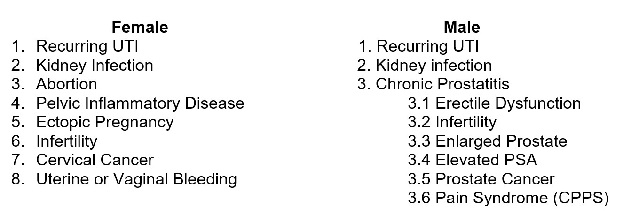


In my 26 years of practice in the field of Genitourinary Medicine, I have seen the magnitude of patients, men and women, young and old suffering from Genitourinary and Prostatitis problems and their anxieties, frustrations and helplessness. Most of these problems were complicated by self medication, non-compliance, recurrence and reinfection. But the biggest thorn I have seen in Genitourinary management is "Prostatitis", because of the inherent failure of antibiotics to enter the thousands of minute glands of the Prostate thus, becoming the root cause of reinfection in men and eventually also infecting back the woman. For as long as Prostatitis is not adequately addressed or dealt with, Genitourinary infection will just be a never ending story. These problems have worsened through the years partly because most patients are still treated separately or individually and the lack of importance given to this field.
Treatment of Genital Infection has become a more tedious process than what it was 26 years ago. The organisms have become more virulent and stubborn, thus, these problems have grown through the years. We have to address them now before it's too late. I am doing my share in disseminating information, hoping to create awareness and understanding.
I. Genitourinary Medicine
Deals with male and female genital and urinary tract infection (GUTI) such as:
II. GUTI Can Affect Everyone
Practically all men and women, young and old can have Urinary Tract Infection, although females are more susceptible to symptomatic UTI than men, especially in their reproductive age or when women are sexually active, thus, the ratio climbs to 30:1 (Stamey).
III. Pathogenesis
How does one get Genitourinary Tract Infection (GUTI)?
There are over 10 different organisms that can infect the male and female genitalia. Most of these organisms are from the skin or intestinal bacteria coming from the anus. Because of the proximity of the Anus to the Vagina, many of these organisms get into the Vagina during sexual contact, when a woman washes her genitals from the back to the front or through oral sex. These organisms can grow or multiply in the Vagina and Cervix causing an infection called Vaginosis and Cervicitis respectively. Generally, this infection goes undetected initially, although few will manifest whitish to yellowish Vaginal Discharge which may be conveniently mistaken as "white menses". So it's common for men and women to have Genital Infection even under a monogamous relationship.
Ascending Infection of the Urethra is the Most Common Cause of UTI
These organisms from the Vagina can get into the female Urethra and cause Urinary Tract Infection (UTI). Since ascending Infection is the most common route of UTI and the female Urethra and Vagina are enclosed together, it's best that, whenever a woman has Urinary Infection, a Gram stain test should also be done in the Urethra, Vagina and Cervix because in all probability the Infection originated from the Vagina and Cervix.
Urinary Tract Infection (UTI)
Is Sexually Transmissible although not necessarily Sexually Transmitted.
Therefore, when a woman who is sexually active has UTI, her regular partner should also be examined and treated with exactly the same medications, otherwise, they will reinfect each other and have the ping-pong effect.
This also holds true with men with UTI. Since both semen and urine passes through the same tract (the Urethra), both should be examined and treated with exactly the same medications.
Generally, Genitourinary Infections may be without symptoms. However, it may manifest as any one or more of the following:


IV. Protect Your Genitourinary & Reproductive System
An inadequately treated Lower Urinary Tract Infection (UTI) may eventually lead to an Upper Urinary Tract Infection involving the kidneys which can be damaged by the said infection.
Chronic Cervicitis, if left unattended, may give rise to Cervical Cancer or may lead to an infection of the Endometrium causing abnormal Uterine or Vaginal bleeding which may necessitate Hysterectomy, or the infection could spread into the Fallopian Tube causing Pelvic Inflammatory Disease (PID) and subsequent obstruction of the Fallopian Tube/s which may cause Ectopic Pregnancy or blockage producing Infertility.
Genital Tract Infection is said to be the most common cause of Infertility in both sexes. Chronic Cervicitis and Endometritis is associated with Infertility in women as well as Ectopic Pregnancy, Recurrent Abortion, Stillbirth and Neonatal Death. In men, Infection can cause deficient Spermatogenesis and Blockage (Jewelewicz & Wallach, 1995). It's important that we recognize that this problem is real and the consequences may be serious or irreparable. So, it is best that men and women starting in their reproductive age should have a regular yearly check-up because most Infections are without symptoms initially.
Chlamydia: is one of the most common infective microorganism for GUTI. The victims of Chlamydia are unsuspecting women and children because they rarely manifest any symptoms until it's too late to help them. Chlamydia could render them Infertile, abort a fetus or infect an infant at birth. Chlamydia trachomatis accounts for 56.8% of cases of Blockage of the Fallopian Tube while Mycoplasma represents 22% of cases (Clausen, 2001).
Among other organisms, Chlamydia is noted to lead to the development of Cervical Cancer in women and Prostate Cancer in men.
V. An Antibiotic Is a Double-Edged Sword
Antibiotics can truly be of help in eradicating organisms, but when taken too short, it can contribute to the emergence of the resistant bacterial strains. It's like breeding monsters. So, don't abuse antibiotics, take it sufficiently. Do not stop an antibiotic until there is proof of a cure, not just by disappearance of symptoms but by complete eradication of the susceptible organisms.
A simple GUTI may have serious consequences because of neglect or ignorance. Treat it adequately, don't leave it to chance. "Do it right, do it once. Do it once, do it right."
VI. COMPLICATIONS OF GUTI
VII. Diagnostic Test for GUTI
- GRAM STAIN - is an important screening test for GUTI and a suitable indicator of the gravity of infection. Although Gram Stain is in no way diagnostic, it acts as a good monitoring guide when to stop medications.
- URINALYSIS - is an unreliable basis for lower urinary infection.
- WET MOUNT - is good for Trichomonas
- DIRECT IMMUNOFLUORESCENCE - is the most reliable test for Chlamydial Infection
- CULTURES - are diagnostic. It identifies the organisms involved and also tells us the appropriate medications to eradicate them. But there are at least 5-7 specific culture media for various organisms necessitating doing varied cultures to identify all of them.
VIII. Common Causes of Failure in the Treatment of GUTI
- Normally, antibiotics given are based on educated guess. But what is best for many is not best for all. So, antibiotics should be Culture-based.
- Generally, GUTI are caused by multiple organisms and there is usually no single medication to eradicate all of them. It may need two or more.
- Antibiotic intake is discontinued too early just as soon as the signs and symptoms have disappeared but before the organisms are completely eradicated. This causes recurrence of GUTI and emergence of a resistant bacterial strain.
- Partners of patients with GUTI are not being treated along with them causing reinfection or the ping-pong effect.
- Presence of "Prostatitis" in the male partner because antibiotics do not readily penetrate the Prostate Gland without the help of Prostate Massage or drainage. Although the organism in the Urethra has been eradicated, the one inside the Prostate remains untouched.
Health Topics

-----













